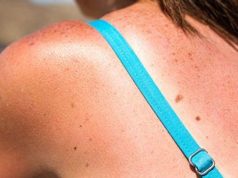Front side showed significantly less non-covered skin than backside; less non-covered skin for females
TUESDAY, July 18, 2017 (HealthDay News) — Routine sunscreen application does not provide complete body coverage, according to a study published online July 12 in the International Journal of Cosmetic Science.
Zorica Jovanovic, Ph.D., from Beiersdorf AG in Hamburg, Germany, and colleagues examined sunscreen application habits and relative body coverage after single whole-body application in 52 healthy volunteers. Participants used the test product once following their usual sunscreen application routine. Before and after product application, standardized ultraviolet photographs were taken and evaluated by image analysis to assess relative body coverage. Sunscreen usage habits were also assessed with an online self-assessment questionnaire.
The researchers found that significantly less non-covered skin was shown on the front side than the backside after product application (4.35 versus 17.27 percent; P = 0.0000). Significantly less non-covered skin was seen among females than males (8.98 versus 13.16 percent; P = 0.0381). Females showed significantly less non-covered skin than males on the backside (13.57 versus 21.94 percent; P = 0.0045), while the difference between females and males was not significant on the front side (4.14 versus 4.53 percent).
“In most cases, the usual sunscreen application routine does not provide complete body coverage even though an extra light sunscreen with good absorption properties was used,” the authors write. “Appropriate consumer education is required to improve sunscreen application and to warrant effective sun protection.”
All authors are employees of Beiersdorf AG, a skin care company.
Abstract
Full Text (subscription or payment may be required)
Copyright © 2017 HealthDay. All rights reserved.








